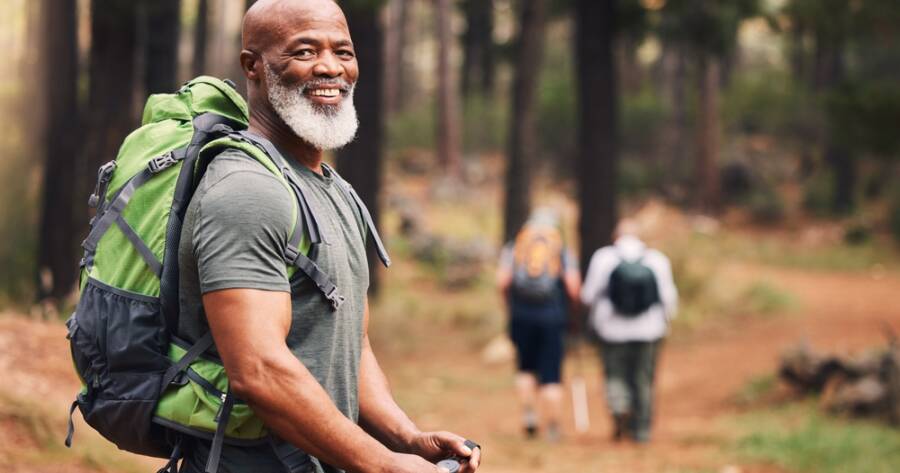Rucking, which involves walking with a weighted backpack, is gaining popularity as a low-impact strength and cardio workout. For seniors, it offers several benefits like improved endurance, posture, and bone health. However, it may also pose risks if not done carefully, especially for those with joint issues or balance concerns. Understanding both sides can help determine if rucking is the right fit.
What is Rucking?
Rucking involves walking or hiking with a weighted backpack, combining the benefits of aerobic exercise with strength training. The term “rucking” comes from “rucksack,” a military term for a backpack. Originally used by soldiers to build endurance and strength during training, rucking has evolved into a popular fitness activity for civilians.
The weight of the backpack provides resistance, enhancing the workout by engaging the muscles of the back, shoulders, core, and legs. Rucking is accessible to almost anyone, as it requires minimal equipment. All you need is a sturdy backpack and some added weight, like water bottles or fitness weights. The simplicity and versatility of rucking make it an appealing exercise option, particularly for those who enjoy walking or hiking and want to add an extra challenge to their routine.
How to Start Rucking: A Step-by-Step Guide for Beginners
Starting rucking is relatively straightforward, but it’s important to begin gradually, especially for seniors. Begin by choosing a well-fitted backpack and start with a light weight, such as 5 to 10 pounds. You can use items like water bottles, sandbags, or weight plates. Start with shorter walks, around 15-20 minutes, on flat terrain to get accustomed to carrying the weight. Gradually increase the duration and intensity of your walks as your strength and endurance improve.
It’s important to maintain good posture throughout the walk by keeping your shoulders back, engaging your core, and avoiding leaning forward. Always warm up before starting and cool down afterward with stretches to prevent injury. As you become more comfortable, consider varying the terrain or increasing the weight to keep the exercise challenging and engaging.
The Benefits of Rucking for Seniors: Building Strength and Stamina
Rucking offers numerous benefits for seniors looking to maintain an active lifestyle. The added weight increases the intensity of a regular walk, helping to build strength in the back, shoulders, and legs while also improving cardiovascular fitness. Rucking is a weight-bearing exercise, which is beneficial for bone health, helping to prevent osteoporosis and maintain bone density. It also promotes better balance and stability, reducing the risk of falls—a common concern for seniors.
Additionally, rucking is a low-impact activity, making it easier on the joints compared to running or high-intensity workouts. It can be done almost anywhere, from local parks to hiking trails (or even around your block if you need to!), providing a versatile and enjoyable way to stay fit and active. With regular practice, rucking can help seniors enhance their overall strength, stamina, and well-being.
Potential Drawbacks: Understanding the Risks of Rucking
While rucking offers many benefits, there are also potential risks, particularly for seniors. The added weight of the backpack can increase strain on the back, shoulders, and knees, especially if the weight is too heavy or if proper form is not maintained. Over time, this strain can lead to discomfort or injury, particularly for those with pre-existing conditions such as arthritis or osteoporosis.
Rucking on uneven terrain can also increase the risk of falls or sprains. It’s essential to listen to your body and not overdo it! Starting with too much weight or walking too far can lead to fatigue or muscle soreness. By understanding these risks and taking appropriate precautions, seniors can enjoy the benefits of rucking while minimizing the chance of injury.
Safety Tips for Seniors: How to Ruck Safely and Effectively
For seniors interested in rucking, safety should always come first. Begin with a light weight and gradually increase it as you build strength and confidence. Ensure your backpack is well-fitted and the weight is evenly distributed to avoid strain on the shoulders and back. Stick to flat, even surfaces initially to reduce the risk of tripping or falling, and consider using trekking poles for added stability. Wear supportive footwear and stay hydrated, especially on longer walks.
If you have any pre-existing health conditions, consult with a healthcare professional before starting rucking. Incorporate warm-up and cool-down exercises to prevent muscle strain, and always listen to your body—if you experience pain or discomfort, reduce the intensity or take a break. With these precautions, seniors can safely enjoy the many benefits of rucking.
Learn More About Rucking
Rucking can be a fantastic way for seniors to stay active, build strength, and improve overall fitness. While there are potential risks, especially with improper technique or overexertion, taking the right precautions can make rucking a safe and rewarding activity. By starting slowly, using proper form, and listening to your body, you can enjoy the many benefits of this simple yet effective workout.
